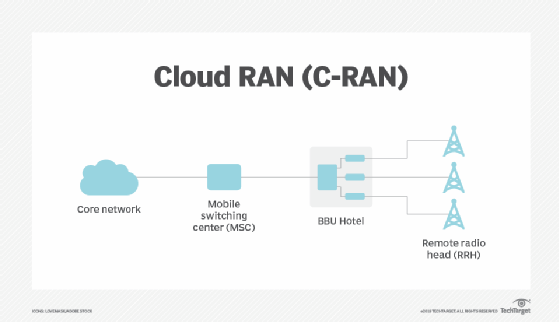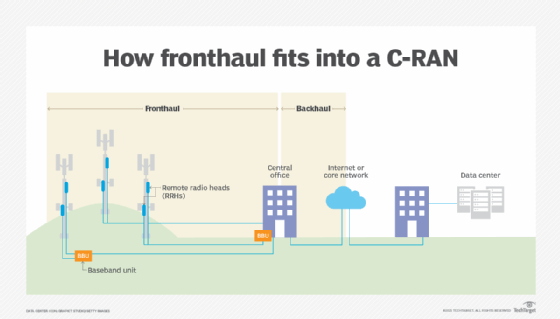fronthaul
Fronthaul, also known as mobile fronthaul, is a term that refers to the fiber-based connection of the cloud radio access network (C-RAN), a new type of cellular network architecture of centralized baseband units (BBUs) and remote radio heads (RRHs) at the access layer of the network.
Fronthaul emerged from the development of Long-Term Evolution-Advanced (LTE-Advanced) networks, which gained International Telecommunication Union (ITU) approval in 2012. Fronthaul complements the backhaul connections between the central network and BBU, enabling the rapid transfer of data and denser network coverage.
Adoption of fronthaul technology has accelerated in recent years with the increasing demand for C-RAN deployments and the emergence of fifth-generation (5G) technology. With 5G technology, fronthaul is used to support all generations of wireless communications. Fronthaul configurations and their adaptability are crucial to balance the latency, reliability and throughput demands of advanced applications on 5G networks.

What is fronthaul?
Fronthaul is made up of standalone radio heads and centralized baseband controllers installed and located at remote cell sites. The RRHs -- also known as radio units -- and BBUs form functional blocks, and the equipment that enables them is located on the cell towers.
In this scenario, the RRH hardware remains at the cell site. The BBU is relocated to a centralized location to serve multiple RRHs. The optical network links that interconnect multiple RRHs with the centralized BBU are called fronthaul.
What is backhaul?
Backhaul is better known than fronthaul. It refers to the connections between a mobile network and a wired network that backhaul traffic from disparate cell sites to a mobile switching telephone office.
These interconnected links form macrocell sites where data is quickly transferred from slower T1/E1 connections based on time-division multiplexing (TDM) to packet-based Ethernet-over-fiber links. These macrocell sites also house BBUs, which process control and user data, and connect to radio units, which generate radio signals.
When it comes to wireless communications, mobile backhaul network architecture enables the transport of voice or data between the wireless access points (APs) to the telephony network or the internet via a wireless local area network (WLAN).

What is the difference between backhaul and wireless fronthaul?
Fronthaul and backhaul both play a part in connecting the end user or node to a major network. A primary difference between fronthaul and backhaul is the part of the network the technology is deployed on. Backhaul links the mobile network to the wired network, while fronthaul describes the network architecture that connects the remote cell sites to the BBU.
More specifically, wireless backhaul is the wireless communication system that gets data from a remote location to a major network. That major network could be the internet or a proprietary enterprise network. In fronthaul architecture, the standalone RRHs at the cell sites are separated from the baseband controller, expanding the signal range of the cell tower.
What are the different types of fronthaul networks?
There are several different types of fronthaul networks that enhance speed and provide low latency. These include the following:
- Enhanced common public radio interface (eCPRI). This fronthaul network helps standardize the split architecture inherent in 5G fronthaul components that separates the RRHs from the BBU. It decreases the data rate demand and complexity between the radio equipment and radio equipment control.
- Passive optical networks (PONs). PONs use optical splitters and point to-multipoint topology.
- Wavelength-division multiplexing (WDM). These networks use laser beams to combine multiple signals at varying infrared wavelengths for fiber-optic transmission. They enhance the efficiency of fronthaul fiber links.
What is 5G fronthaul?
5G fronthaul facilitates enhanced mobile broadband (eMBB), ultra-reliable low-latency communications (uRLLC) and massive machine-type communication (mMTC) for internet of things (IoT) networks. 5G provides gigabit (Gb) speeds and low latency, and it helps establish fronthaul transport capacity.
Fronthaul enhances network performance, making it more flexible and efficient. However, many factors must be considered before adopting it, including the type of spectrum, amount of fiber on the ground, available expertise and network topology.
The evolution of fronthaul
Fronthaul in mobile networks evolved as the need for bandwidth and low latency increased. In addition, as the demand for optical networks in broadband services grew, so did the fronthaul market.
The emergence of next-generation RAN accelerated fronthaul fiber deployments. Split fronthaul architecture, multiplexing and virtualization supported these fiber deployments, and as such, eCPRI fronthaul is now critical to 5G technology.
Before fourth-generation (4G) technologies, fiber optics dominated transport networks. Disparate radio elements were connected to various centralized controllers through CPRI, which emerged in 2003 and was called the mainstream transport protocol in modern fronthaul networks.
The subsequent development of multiple input, multiple output (MIMO) technologies enabled higher-order multicarrier configurations. This type of interface supported shared infrastructure and dynamic capacity allocation and helped bring about a completely open RAN that is used for 5G applications and deployments.
Among the challenges facing the development of mobile fronthaul networks are limited network options and a shortage of expertise in the field. These issues could restrict growth over the next few years. But 5G networks offer lucrative opportunities to scale, and enterprises are expected to overcome these challenges.
It's early days for 5G technology. Learn about the different types of 5G and how they are changing telecom.





